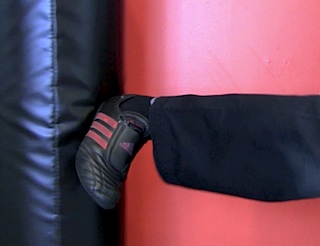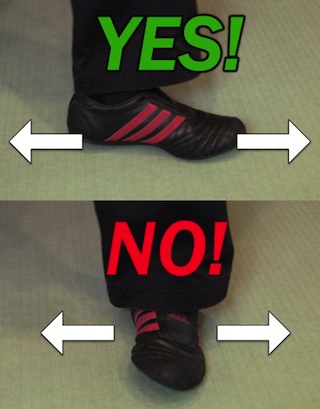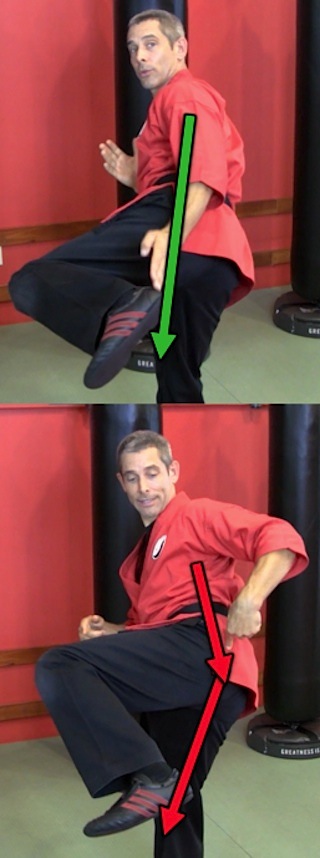Bad side kicks. You see them everywhere…
Movies, commercials, fitness classes… even in kickboxing and martial arts classes!
Models, actors, and wanna-bes all throwing side kicks with their knee crooked, toes sticking up, and sometimes even their tongue hanging out.
Side kick like that in a real fight and you’ll get dropped on your head. I don’t want that to happen to you!
Let me share three side kick tips to help keep you on your feet. If the video doesn’t play, you can find a summary below. Happy kicking!
If you read, How to Punch Harder Using a Wall, you know I’m a big fan of proper body alignment. In fact, I think you should listen to your body more than your teacher!
Here are two questions you should ask your body when learning to throw a side kick…
QUESTION #1: Should I side kick towards my side or towards my rear?
Try this simple test—swing your leg forward and backward. Then swing it from side to side.
I’ll bet one of those movements feels strong and natural, while the other… not so much.
QUESTION #2: Should I kick with the heel or the blade of my foot?
Try this—walk around on your heels. Then walk around on the blade of your foot.
Take it a step farther by stomping on your heels. Wait! Don’t do that. You might break your ankle.
Okay, so what side kick tips did your body just give you?
1) Throw your side kick towards your rear, not your side.
2) Kick with the heel, not the side of your foot.
The reason for both is simple—
Your feet, knees, and hip are built to deliver and absorb pressure moving along the joints, not across the joints.
 Moving straight forward and backward is how you’ve been walking, running, jumping, and climbing your whole life. If you put pressure across your ankle, knee, or hip, you’re just asking for pain and trouble.
Moving straight forward and backward is how you’ve been walking, running, jumping, and climbing your whole life. If you put pressure across your ankle, knee, or hip, you’re just asking for pain and trouble.
Yes, if you side kick at low targets, like ankles and knees, you can get away with it, but as a rule…
The higher you kick, the more you should pivot your body.
Yes, you’ll see some martial arts hot shots out there swinging their leg up sideways, but 1) they’re usually in their 20’s, and 2) they’re usually not hitting anything. Consider this—
Impact changes everything. That’s why you should pressure test your kicks on bags, boards, or bad guys.
Of course, if kicking to the side is working for you, kick however you like! But for me, the risks outweigh the rewards. Especially as I get older! 🙂
3 Side Kick Tips for Power and Balance
So, now that we’re listening to what our body has to teach us, let’s get to the tips.
 TIP #1: Turn your support foot so the line of force runs along the foot, not across it.
TIP #1: Turn your support foot so the line of force runs along the foot, not across it.
Offensively, you don’t want to push or drive into your kick off the side of your foot.
Defensively, you don’t want to get your kick jammed or thrown back at you, causing you to roll your ankle or tear your knee.
Turn the support foot around so that your body is aligned almost backwards to the target, not sideways.
But wait! Isn’t that the same as a back kick?
No! A back kick requires a full 180 degree pivot. The side kick can be less than 180.
TIP #2: Kick with the heel.
I know, I know—some teachers kick with the blade of the foot. But I’m not one of them and now you know why.
When I kick with the blade, the pressure moves across my foot and knee. When I kick with my heel, however, there’s an alignment of bone and muscle behind it. It feels just as strong as stomping on the ground.
That’s good for me and bad for the other guy!
TIP #3: Get your butt in line.
This tip may be the only one you need, because if you do it right, both feet will take care of themselves.
 The idea is to get your butt in line with the kick. In other words, align your glutes between your torso and the kicking foot.
The idea is to get your butt in line with the kick. In other words, align your glutes between your torso and the kicking foot.
When your glutes are out of alignment, they won’t be able to deliver or absorb force at the moment of impact. Instead, you’re going to be pinching your ribs and hip together, which puts stress on an area of your body that can’t handle it.
Be warned! Some people can pivot their foot, stick their heel out, but still not have their glutes lined up with the target! That’s trouble.
So, if you remember nothing else, remember this—
Aim your butt. Kick their butt.
The key to accomplishing all of this is executing a full pivot. You can time that pivot a few different ways…
√ You can pivot fully first, then stick out the leg.
√ You can pivot half-way, then finish the pivot on impact.
√ You can shoot your foot straight to the target with no pivot, then crank your hips right at the moment of impact.
I leave the timing up to you. Just make sure that when your foot strikes the target, your body is in the same natural position as when you swing your leg and stomp your heel.
Of course, this is all under ideal circumstances. The full pivot isn’t always easy to pull off.
When you’re sparring hard or fighting for your life, body movements tend to get shorter and choppier. Under pressure, even an expert can get caught sticking out a leg without fully pivoting. The solution?
Pay attention when you practice. Practice the ideal kick as much as you can so you will build the strongest habits possible.
If you don’t, not only will your kicks be weak, not only will you look ridiculous, but over time, there’s a good chance you’re going to end up with back pain, knee issues, and maybe even need a hip replacement.
And that’s only if you don’t get killed in a real fight first!
So, listen to your body. It has a lot more to teach you than just a few side kick tips.

Helpful explanation I never received in my prior instruction… and I just love it when it makes sense, Sensei!
Comments like yours make me smile– thank you! 🙂
Isn’t it amazing how something taught on day one in one school is an advanced lesson in another school or never taught at all in another school? That’s why it’s so important to keep talking to each other! Thanks for commenting!
Hi Sensei,
I found this article today beause I was feeling so discouraged after my belt test last night. When side kicks have been in a form, I have just tried to fake them and make everything else look better. But one of my boad breaks this time was a side kick 🙁 The other 2 were front and round kicks. I was able to do both of those with an ATA brown board. I can do black but they didn’t have it out. For the side kick though, I had to use the orange (the one for little kids) and I was actually relieved I broke it on the first try. It was so embarrassing. So today I decided there had to be something I could do. My whole body just always felt off doing side kicks (and hook kicks too…. if you have any tips for those….). After reading though your tips a few times and trying them out on a large target to get a feel for it I was feeling pretty optimistic, so I grabbed our set of boards and took them to my husband, and asked him to hold for me. I started with orange: right through, didn’t feel like I was going to lose my balance like I always have with side kicks. Then I had him hold green: right through. Then blue (as an adult purple belt (maybe soon-to-be blue belt) this is the board I should be able to break consistently): first try was a no-go. Second try it went right though. I’m so happy right now.
Hi Lisa!
Congratulations on the belt test! But the real cause for celebration is the fact that you sought to improve yourself RIGHT AFTER! That tells me you’re the real deal… a real martial artist. Good for you!
I’m thrilled to hear that my article was helpful. Thanks for letting me know! I address hook kicks in another article here:
http://www.senseiando.com/hook-kick-round-kick-chamber-tip/
Let me know how that one goes! No matter what, keep kicking! 🙂
Ando
Thanks sensei Ando, I love your lessons, particularly the focus on injury prevention, for a 55-y-o like me, that’s so important.
Great stuff.
Hi Lock! Thanks for sropping by! Yes, self-defense starts with defending ourselves FROM ourselves.
Let’s push ourselves without hurting ourselves. Happy training!